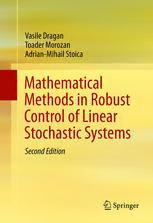Table Of ContentVasile Dragan
Toader Morozan
Adrian-Mihail Stoica
Mathematical
Methods in Robust
Control of Linear
Stochastic Systems
Second Edition
Mathematical Methods in Robust Control of Linear
Stochastic Systems
Vasile Dragan • Toader Morozan
Adrian-Mihail Stoica
Mathematical Methods
in Robust Control of Linear
Stochastic Systems
Second Edition
123
VasileDragan ToaderMorozan
InstituteofMathematics InstituteofMathematics
oftheRomanianAcademy oftheRomanianAcademy
Bucharest,Romania Bucharest,Romania
Adrian-MihailStoica
UniversityPolitechnicaofBucharest
Bucharest,Romania
ISBN978-1-4614-8662-6 ISBN978-1-4614-8663-3(eBook)
DOI10.1007/978-1-4614-8663-3
SpringerNewYorkHeidelbergDordrechtLondon
LibraryofCongressControlNumber:2013945412
MathematicsSubjectClassification(2010):93E03,93E11,93E15,93E20,93E25,60J22
©SpringerScience+BusinessMediaNewYork2006,2013
Thisworkissubjecttocopyright.AllrightsarereservedbythePublisher,whetherthewholeorpartof
thematerialisconcerned,specificallytherightsoftranslation,reprinting,reuseofillustrations,recitation,
broadcasting,reproductiononmicrofilmsorinanyotherphysicalway,andtransmissionorinformation
storageandretrieval,electronicadaptation,computersoftware,orbysimilarordissimilarmethodology
nowknownorhereafterdeveloped.Exemptedfromthislegalreservationarebriefexcerptsinconnection
with reviews or scholarly analysis or material supplied specifically for the purpose of being entered
and executed on a computer system, for exclusive use by the purchaser of the work. Duplication of
this publication or parts thereof is permitted only under the provisions of the Copyright Law of the
Publisher’slocation,initscurrentversion,andpermissionforusemustalwaysbeobtainedfromSpringer.
PermissionsforusemaybeobtainedthroughRightsLinkattheCopyrightClearanceCenter.Violations
areliabletoprosecutionundertherespectiveCopyrightLaw.
Theuseofgeneraldescriptivenames,registerednames,trademarks,servicemarks,etc.inthispublication
doesnotimply,evenintheabsenceofaspecificstatement,thatsuchnamesareexemptfromtherelevant
protectivelawsandregulationsandthereforefreeforgeneraluse.
While the advice and information in this book are believed to be true and accurate at the date of
publication,neithertheauthorsnortheeditorsnorthepublishercanacceptanylegalresponsibilityfor
anyerrorsoromissionsthatmaybemade.Thepublishermakesnowarranty,expressorimplied,with
respecttothematerialcontainedherein.
Printedonacid-freepaper
SpringerispartofSpringerScience+BusinessMedia(www.springer.com)
Toourwives,Viorica,ElenaandDana
fortheirlove,patienceandsupport.
Preface to the First Edition
This monograph presents a thorough description of the mathematical theory of
robust linear stochastic control systems. The interest in this topic is motivated
by the variety of random phenomena arising in physical, engineering, biological,
and social processes. The study of stochastic systems has a long history, but two
distinct classes of such systems drew much attention in the control literature,
namelystochasticsystemssubjectedtowhitenoiseperturbationsandsystemswith
Markovian jumping. At the same time, the remarkable progress in recent decades
in the control theory of deterministic dynamic systems strongly influenced the
research effort in the stochastic area. Thus, the modem treatments of stochastic
systems include optimal control, robust stabilization, and H2-and H∞-type results
for both stochastic systems corrupted with white noise and systems with jump
Markovperturbations.
Inthiscontext,therearetwomainobjectivesofthepresentbook.Thefirstoneis
todevelop amathematicaltheorylineartime-varyingstochasticsystemsincluding
both white noise jump Markov perturbations. From the perspective of this gener-
alized theory the stochastic systems subjected only to white noise perturbations
or to jump Markov perturbations can be regarded as particular cases. The second
objectiveistodevelopanalysisanddesignmethodsforadvancedcontrolproblems
of linear stochastic systems with white noise and Markovianjumping as linear-
quadraticcontrol,robuststabilization,anddisturbanceattenuationproblems.Taking
intoaccountthemajorroleplayedbytheRiccatiequationsintheseproblems,the
book presents this type of equation in a general framework. Particular attention is
paidtothenumericalaspectsarisinginthecontrolproblemsofstochasticsystems;
new numerical algorithms to solve coupled matrix algebraic Riccati equations are
alsoproposedandillustratedbynumericalexamples.
The book contains seven chapters. Chapter 1 includes some prerequisites
conceming measure and probability theory that will be used in subsequent devel-
opments in the book. In the second part of this chapter, detailed proofs of some
new results, such as the Itoˆ-type formula in a general case covering the classes
of stochastic systems with white noise perturbations and Markovian jumping, are
vii
viii PrefacetotheFirstEdition
given.TheItoˆ-typeformulaplaysacmcialroleintheproofsofthemainresultsof
thebook.
Chapter 2 is mainly devoted to the exponential stability of linear stochastic
systems. It is proved that the exponential stability in the mean square of the
considered class of stochastic systems is equivalent with the exponential stability
of an appropriate class of deterministic systems over a finite-dimensional Hilbert
space. Necessary and sufficient conditions for exponential stability for such de-
terministic systems are derived in terms of some Lyapunov-type equations. Then
necessary and sufficient conditions in terms of Lyapunov functions for mean
square exponential stability are obtained. These results represent a generalization
oftheknownconditionsconcemingtheexponentialstabilityofstochasticsystems
subjectedtowhitenoiseandMarkovianjumping,respectively.
Some stmctural properties such as controllability, stabilizability, observability,
and detectability linear stochastic systems subjected to both white noise andjump
MarkovperturbationsareconsideredinChapter3.Thesepropertiesplayakeyrole
inthefollowingchaptersofthebook.
InChapter4differentialandalgebraicgeneralizedRiccati-typeequationsarising
in the control problems of stochastic systems are introduced. Our attention tums
to the maximal, minimal, and stabilizing solutions of these equations for which
necessary and sufficient existence conditions are derived. The final part of this
chapterprovidesaniterativeprocedureforcomputingthemaximalsolutionofsuch
equations.
In the fifth chapter of the book, the linear-quadratic problem on the infinite
horizonforstochasticsystemswithbothwhitenoiseandjumpMarkovperturbations
isconsidered.Theproblemreferstoageneralsituation:Theconsideredsystemsare
subjectedtobothstateandcontrolmultiplicativewhitenoiseandtheoptimization
is performed under the class of nonanticipative stochastic controls. The optimal
control is expressed in terms of the stabilizing solution of coupled generalized
Riccati equations. As an application of the results deduced in this chapter, we
considertheoptimaltrackingproblem.
Chapter 6 contains corresponding versions of some known results from the
deterministiccase,suchastheBoundedRealLemma,theSmallGainTheorem,and
thestabilityradius,fortheconsideredclassofstochasticsystems.Suchresultshave
beenobtainedseparatelyinthestochasticframeworkforsystemssubjectedtowhite
noise and Markov perturbations, respectively. In our book, these results appear as
particular situations of a more general class of stochastic systems including both
typesofperturbations.
In Chapter 7 the γ-attenuation problem of stochastic systems with both white
noise and Markovian jumping is considered. Necessary and sufficient conditions
for the existence of a stabilizing γ-attenuating controller are obtained in terms
of a system of coupled game-theoretic Riccati equations and inequalities. These
resultsallowonetosolvevariousrobuststabilizationproblemsofstochasticsystems
subjected to white noise and Markov perturbations, as illustrated by numerical
examples.
PrefacetotheFirstEdition ix
Themonographisbasedentirelyonoriginalrecentresultsoftheauthors;some
of these results have been recently published in control joumals and conferences
proceedings.Therearealsosomeotherresultsthatappearforthefirsttimeinthis
book.
Thisbookisnotintendedtobeatextbookoraguideforcontroldesigners.We
hadinmindaratherlargeraudience,includingtheoreticalandappliedmathemati-
cians and research engineers, as well as graduate students in all these fields, and,
for some parts of the book, even undergraduate students. Since our intention was
to provide a self-contained text, only the first chapter reviews known results and
prerequisitesusedintherestofthebook.
The authors are indebted to Professors Gerhard Freiling and Isaac Yaesh for
fruitfuldiscussionsonsomeofthenumericalmethodsandapplicationspresentedin
thebook.
Finally,theauthorswishtothanktheSpringerpublishingstaffandthereviewer
forcarefullycheckingthemanuscriptandforvaluablesuggestions.

